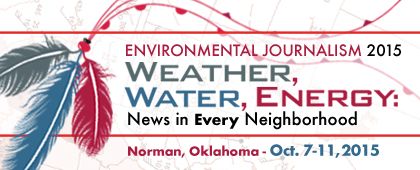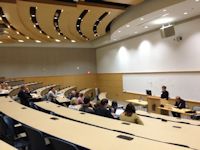Journalists are eligible for free email subscriptions: TipSheet and WatchDog TipSheet (on access issues).

| AGENDA | REGISTRATION |
| Agenda | Coverage | Lodging/ Travel | Exhibits/Receptions | Environmental News | About Norman |
SEJ's Environmental Journalism 2015 is hosted by
The University of Oklahoma.
Conference location: Embassy Suites and Convention Center
2501 Conference Drive in Norman, OK, 73069
 |
| Images courtesy of Brent Fuchs, Sarah Terry-Cobo and StateImpact Oklahoma |
Welcome to Oklahoma. Prepare to be surprised!
We’re glad you’re joining us in the Sooner State, a land of ancient mountains, endless skies and waving prairie.
And, we’re pleased to be hosting you at one of its most beautiful times – October. The state’s 12 distinct eco-regions include hardwood forests of eastern Oklahoma, which should be a mash of reds, oranges and yellows, and the Tallgrass Prairie, which will be adorned in its autumnal hues.
|
Apply for a
|
Those of us who live on the Great Plains know you call our home “flyover country.” You won’t think that after you leave. We and our host, the University of Oklahoma, will fill your notebook with story ideas. This is a state wedded to its land, and its accomplishments are impressive. Did you know, e.g., that Oklahoma has cleaned up more EPA-listed impaired waterways than any other state in the nation?
We’ve put together a “two-fer” because we realize the story-telling landscape has changed. You’ll get a heavy dose of video and graphics training along with SEJ’s noteworthy sessions on content.
OU’s Gaylord College of Journalism and Mass Communication is opening its media labs so we can offer hands-on training. Google is sending a trainer to demonstrate its free maps, charts and graphics tools. SEJ will teach entry-level classes on the use of smartphones for video, and Gaylord will lead an advanced video class. Friday night, we’ll screen documentaries, munch on popcorn and talk about visual storytelling.
This is a land where battles over water and energy are writ large, where climate and severe weather dominate life. We won’t shy away from any of this. Global warming still in dispute? EPA scientists not accessible? We’ve invited Sen. James Inhofe and EPA Administrator Gina McCarthy to share the podium, and we’ll give you the microphone for questions.
Oklahoma was built on Big Oil and agriculture, but the state lives or dies by the availability of water. The result is well-funded energy, water and ag research at public and private centers in Oklahoma. Many have invited us into their labs. Got questions about fracking and earthquakes? Plant genetics? Water law? Learn the science and why some questions don’t yet have answers.
Some of the planet’s most violent and extreme weather is found here, and so is one of the world’s leading centers for severe weather research. The National Weather Center brings together OU, NOAA, state agencies and private industry. The synergy of this research will be open to SEJ, and we’ll focus on the changing nature of extreme weather in a warming world.
In Oklahoma, we’ll bear witness to the ability of people to recover from tragedy, and we’ll have a chance to examine our role in documenting it. In the Territory where tribes were forced to migrate, Native Nations now work to preserve the environment, diversify tribal-owned businesses and help their own members. On the occasion of the 20th anniversary of the Oklahoma City bombing, we hope to offer attendees a joint session with journalism historians at the national memorial and museum.
This is tough country, and its people are tougher. Come to the heart of Conservative America and learn why those of us who live here, love it. Our friends work hard, play hard and care deeply, including those who disagree with us.
Our conference hotel is proving ideal for keeping costs down. Each room is a suite, so you can double-bunk while maintaining your privacy, or you can pile in more people for even greater savings. The rooms come with a free breakfast and happy hour!
Sure, we’ve got cattle and hogs, wheat and sorghum, but this is also the land of peaches, peanuts and pecans. Come enjoy some of our specialties, take home a care package of Great Plains goodness.
Come to Oklahoma. We’ve set the table.
Conference Co-Chairs:
Nancy Gaarder, Omaha World-Herald | Omaha.com
Sarah Terry-Cobo, The Journal Record | JournalRecord.com (Oklahoma City)
Sign up for email updates about SEJ's 25th Annual Conference.
About The University of Oklahoma
The University of Oklahoma is a pacesetter in American public higher education. OU is classified by the Carnegie Foundation as a Very High Research institution, placing it in the highest tier of research universities in the nation, and OU’s Research Campus is ranked among the nation’s top research parks by the Association of University Research Parks. Anchoring OU’s Research Campus, the National Weather Center houses academic, state and federal entities, all collaborating with a common purpose. OU’s Research Campus is also home to the Department of Interior’s South Central Climate Science Center, a consortium of four regional universities, two tribal nations and a national laboratory. With the opening this fall of the state-of-the-art Radar Innovations Lab, the eighth research facility to be built on the site in less than a decade, the OU Research Campus topped 1 million square feet of occupied space in less than a decade.
Resources and Contacts for Environmental Journalism 2015 / SEJ's 25th Annual Conference:
- Advanced Radar Research Center
- Gaylord College of Journalism and Mass Communication at the University of Oklahoma
- Langston University College of Agriculture and Applied Sciences
- Langston University Department of Communication
- Native American Journalists Association
- OU College of Atmospheric and Geographic Sciences
- OU Vice President for Research on the Norman Campus
- OU College of Arts and Sciences
- OU College of Engineering
- Oklahoma Climatalogical Survey
- Oklahoma Wind Power Initiative
- Sarkey’s Energy Center
- South Central Climate Science Center (consortium of OU, Texas Tech, OSU, Chickasaw Nation, Choctaw Nation, Louisiana State and NOAA)
About Oklahoma
The Sooner State has more to offer than just extreme weather and waving prairie grasses. It has 12 distinct ecological regions, including swampy bayou in the southeast, rolling valleys thick with hardy oak trees in the northeast, dusty plains in the southwest, and high plateaus in the Panhandle. Its capital city does have a working stockyard, but it's not a sleepy cow town anymore. Oklahoma City, and our nearby host city Norman, have up-and-coming nightlives, with restaurants and bars that serve locally-sourced produce, meats, honeys and sauces. Norman has extensive bike trails connecting a network of city parks. And perhaps a shocker for environmental journalists: Oklahoma is the nation's leader in cleaning up its rivers and creeks under the Clean Water Act. It has removed more polluted water bodies from the U.S. Environmental Protection Agency's impaired waters list than any other state. Through voluntary conservation programs, farmers, ranchers and landowners are working together with the EPA, U.S. Department of Agriculture's Natural Resources Conservation Service and local county conservation agents to improve water quality.
Oklahoma City is nationally known for its voter-approved, one-cent-sales tax increase initiatives over the last two decades. The MAPs program has transformed Bricktown, formerly an industrial neighborhood, into a bustling, mixed-use district with restaurants, clubs, a baseball stadium with a riverwalk-style water taxi. In recent years, the MAPs initiative has helped revitalize OKC's downtown, redesigning streetscapes to catch and filter stormwater runoff, creating a park with native plants around the Myriad Botanical Garden, and building a convention center that's now home to the Oklahoma City Thunder NBA team.
Though Oklahoma is often considered the buckle of the Bible Belt and is a bastion of conservatism, policy makers can create surprisingly progressive programs. In 2012, the legislature passed the Water for 2060 Act, a law that requires each watershed region project demand and plan for adequate water supplies for residents, municipalities, industry and agriculture for the year 2060. The law is seen as a model for drought preparation and mitigation in the West.

















 Advertisement
Advertisement 



